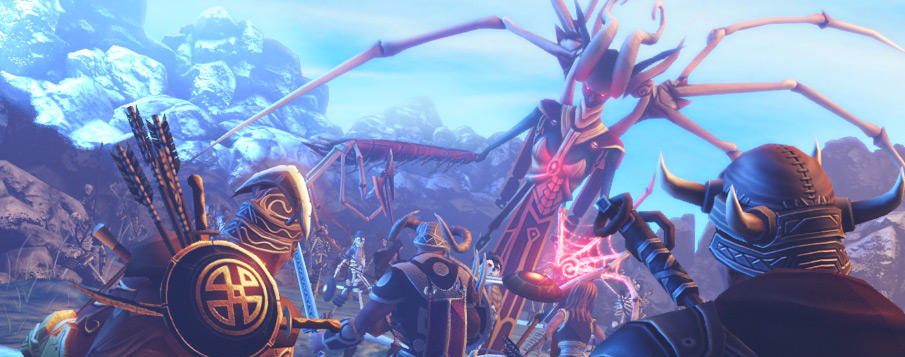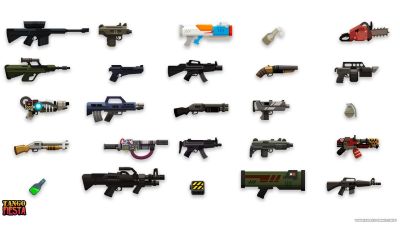Kyn (pronounced kin) is a single-player tactical ARPG that indie developer Tangrin are promising will have “exciting team combat” and “an engrossing world worth exploring.” We took a look over a preview build to get a sense of how the Dutch two-man development team is getting on fulfilling those promises.
The good news? Most of what can be seen is encouraging, even if there is some room for improvement.
The demo is broken down into two levels. The first appears to be from the very beginning of the game and teaches the basic mechanics. The second level is from the mid-point of the game - and it was here where we got to play around with the leveling-up system, see the consequences of our actions in the first level and get a feel for how team synergy shapes Kyn’s combat.
The demo opens with our heroes, Alrik and Bram, hobbling out of a cave. It’s clear these two have been holed up in the cave together as part of some kind of training regimen for a long-time - Long enough that they are comfortable in each other’s company, exchanging friendly albeit antagonistic banter. Tired and hungry, our heroes make for home, which is eastwards (or rightwards under Kyn’s fixed isometric camera view).
Movement is mouse-driven; clicking on the terrain will send your heroes scurrying over to your cursor. During the time taken to catch up to their destination markers, we scrolled ahead into the fogged-out area further down the path. Heading home directly—as the mini-map suggested—didn’t look like an option; the bridge leading into town had collapsed, leaving us no other choice but to circle around the long way.
Shortly into this little trek, we came across a distraught merchant. Stock from his cart was haphazardly strewn around the path, his horse appeared to have bled out, and a girl lay motionless on the ground next to him. The scene told its own tale. The merchant begged the heroes to revive the little girl, insisting that they were the only ones that could. He had a point: in Kyn’s world, magic is a powerful force that only a select few are permitted to wield. This provides the narrative justification for the heroes to side-quest on the behalf of NPCs; quests only they are capable of undertaking.
In Kyn, these side-quests are called ‘Pacts’. Think of them as “side-quests with transparency”: not only are the quest givers visible on the map but (as I find out later), but so are the quest destinations. In a nice touch, you get to see and inspect the reward items upfront.
In this case, the reward was a paltry wooden shield with an Armor value of 4 and a resale value of 16 gold. Of course, we didn’t need an added incentive to do a good deed. After all, reviving someone with the Rebirth skill wasn’t that big a deal; while using magic does cost resources, depleting a bar under each character’s portrait (representing their “spirit”), it auto-regenerates over time. We revived the girl and went on our way, shield in hand.
A little later on, we came across a town which served as an excellent source of information, filling us in on the background of the world. The people of the major villages are at odds with groups of vagabonds called the “Eshir”, or “Reds” - due to their red attire. Some of the men in the village went out to launch an attack on Eshir encampments, but have yet to return. The villagers fear the worst; we made a Pact with one of them, promising to see what had become of their missing brethren.
The Eshir encampments were easy enough to find - being marked on the mini-map and all - but taking the Eshir down turns out to be a little different than anticipated. Up until this point, we had fought simple-minded Skeltar (undead skeletons) and wild boars. But looking over the Eshir encampments from a distance, it became clear that this mission would be a little different; the Eshir were divided into front-line melee attackers, backline archers, and two other classes whose function wasn’t immediately obvious.
We concocted a simple plan: to rush in with Bram and get the attention of the melee fighters, while Alrik slipped around the side and took out the archers. You need to plan ahead like this, because once you are in combat you can’t pause the action or access your inventory; mid-battle re-jigging of your skills and equipment isn’t viable.
The plan is crude but it works…kind of. The two remaining classes refuse to fight back and start running around, making it impossible to click on them. Thankfully, this was easily remedied; a tap of spacebar grants a few seconds of slow-motion time to help you issue commands and target enemies. We cleared out the encampment and liberated the captured villagers.
It was only upon zooming the camera in to take a look around the encampment that we realized what those two unidentified classes were: women and children. These ‘Reds’ are people, just like the ones back at the village, and we’d indiscriminately slaughtered them. It was a troubling feeling. Still, there was loot to receive - so we journeyed back to the village to pick up our reward, though knowing it came at the expense of innocent lives made it something of a consolation prize.
Fortunately, not all the encounters in Kyn require you pick your targets so carefully.
In an Undead stronghold where there was no need to hold back, we got a taste of the promised “exciting team combat”. We crashed into the courtyard to clear out the first wave of Skeltars with ease, before funneling our heroes up a narrow staircase. We were greeted by several more enemies at the summit, many of them bigger than the ones before. Using Bram, we managed to take down most of the smaller ones, but one of the heavies got in a crushing blow. Without his companion (and because we’re pretty cowardly gamers), there was only one thing for Alrik to do - make a run for it.
We managed to run far enough so that only the most persistent small-fry remained in pursuit. After picking them off from a distance, we made our way back to the foot of the staircase; Bram was still lying still at the top, right in the line of sight of the patrolling heavies. We were down to one character and two skills: Rebirth and Spiked Trap.
Finding a gap in the patrol gave us enough time to set-up a spike-trap at the foot of the stairs, before dashing back to revive Bram our Rebirth spell. However, there was no time for celebration; the patrols had spotted us and were headed our way. After limping our way down the stairs and into the courtyard, we managed to get away just in time to see the pursuing heavies impale themselves on a spike-trap.
That daring rescue in the Undead stronghold is just one example of the kind of personalized story players will take away from their experience with Kyn. And it isn’t just the combat: the exploration also gives players the opportunity to have their own story moments. For example, in an optional puzzle we were tasked with hitting switches to maneuver water-flow through gates in a moat. The goal was to get the water level just high enough that we could use buoyant wood as a makeshift bridge. The puzzle design is Tangrin’s, something that every player experiences, but the approach taken to work out how the various switches worked and what order to press them was our own.
The first level closes with the heroes coming across a curious scene - a soldier being interrogated by a girl. He doesn’t have the information she needs, and with that his usefulness to her is spent; she reduces him to ash with a lightning spell far more powerful than anything the heroes can muster. It appears that in Kyn’s world not all magic users are upright individuals.
The second level in the preview demo jumps ahead to the mid-point in the game and we find ourselves in a village which acts as a hub world between major story missions. It’s here that you can buy weapons, craft them (free, but you need the prerequisite materials) and see the effects of your earlier actions.
Walking around the town, we hear the townsfolk gossiping about the Eshirs we’d previously slain. Opinion was divided; some sympathized with their losses and others saw them as sub-humans in need of culling. The merchant and little girl we’d helped out earlier were also around, and thankful to be so. In the demo, the effects of player actions in the world are ornamental. We’re curious to see if, and how, actions in the wider world will impact the player in the final game. But towns in Kyn aren’t just there to show the consequences of your decisions; they’re also important because of how they tie into the leveling system. Characters level up each time they return to town, linking character growth to story progression. Enemies drop loot, not XP - ensuring that you don’t need to take the violent path to victory in order to progress your abilities.
Checking out the character status screen (which is curiously referred to as the ‘Villagers’ menu) we found that Bram and Alrik were now a mid-game level 9, granting them the ability to equip more powerful weapons and armor than they previously could, provided their stats—Body, Mind and Control—were high enough to meet equip conditions.
These stats come with their own respective skills trees. Raising the Body stat increases all things physical; your Attack, Health and Armor rating. Body skills improve your physical prowess in battle; temporarily boosting Armor or Attack for example. Raising Mind improves the number of Spirit Points you can expend on magic, as well reducing your Spirit Regeneration time. Mind Skills consist of debilitating hexes and healing spells. Lastly, Control is a mixture of Mind and Body; raising it increases your Spirit Points, Health and Attack Rate per second. Control skills are about dexterity and sabotage; setting the enemy on fire and draining their health or deftly tossing a trio of grenades at an enemy’s feet.
Interestingly, the demo allowed us to re-spec characters freely at any time, refunding spent points so that we could try other builds. It’s not known if this is a quirk of the demo, or a player-friendly design choice.
Each character can have two of these skills equipped at once. But they also have a third skill slot set aside for “Feedskills”: powerful non-Spirit skills that need to be ‘fed’ by their respective element before use. Each skill tree has its own set of Feedskills. Which Feedskill you draw out depends on the type of Feedstone you equip.
If that’s too messy to follow, an example might help: take the Mind skill tree’s Feedskill selection. Equip that, and you have a choice of three Feedskills you can activate. Different Feedstones activate different skills. For example, if you equip a Life Feedstone in conjunction with the Mind Feedskills selection; you get the Life Feedskill “Project Lifevial”. The Life Feedstone’s element is Life, so healing feeds the Feedskill gauge; fill the gauge up and you can use the skill in battle. Project Lifevial allows the user to cast a potent area-of-effect healing spell. We also found a Feedskill that was activated by the Death Feedstone, which increased the attacker’s attack power with each successive kill.
Your regular attack and these three skills are the only things your characters have at their disposal in a fight. The synergy between these skills and your characters is a key part of combat strategy. For instance, the Terror skill causes enemies to flee in fear, exposing their backs, and the Backstab skill increases the damage the attacker gets from attacking an enemy from behind. Combine these skills and you have a decent advantage; thinning enemy ranks by taunting them into chasing one of your characters around a raised platform, as another character picks them off with arrows from above, is another great example of teamwork synergy.
If there is one dour note about our time with Kyn, it would be the inventory UI. Hitting the I key always pulls up Alrik’s inventory panel, rather than the currently selected characters’. The inventory is kind enough to sort items into broad tabs such as weapons, armor and crafting items but I find that trying to differentiate which items your character can and can’t equip is messy; hovering the cursor over every single headpiece, sword and pointy doo-dad is cumbersome. Simply graying out the stuff that can’t be used would be better. Finally, you can’t see and compare the stats of your equipped item and prospective equipment at the same time; you’re stuck having to examine the tool tip on your sword, memorizing every detail and then checking the tool tip of the prospective equipment; in the end you’ll go back and forth between the two several times before coming to a decision.
We went into Kyn interested in seeing how combat and exploration plays out, and walked away with a small collection of ‘war stories’ about the time we were holed-up against a marauding group of scorpions, or the time we lured my enemies into an ambush. It looks like Tangrin’s promises may be fulfilled. Kyn is scheduled for release on Windows, Linux and Mac in Summer 2014; hopefully giving the developer enough time to iron out some of the UI kinks; based on this early evidence, it will be worth waiting for.




